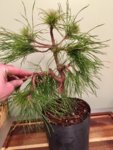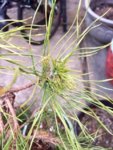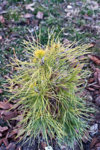G. Wires,
I think you're right about foliage coming directly from the bud. I've attached pictures below of the bud/candles. They haven't fully hardened off, but aren't buds either. I believe the shorter needles are last year's bud/candles that seem frozen in place since I received the tree, no new growth yet since spring hasn't really started. Yes the newer needles are much smaller (~1”) than the extremely long (seemingly weak) older needles (+4”). I’ve heard pines get their strength from their roots more than vascular or foliage and although the tree isn’t completely root bound, it is getting very crowded for sure, so maybe that is the cause of less vigorous new growth? Should I leave upper tree to heal, do a minor root prune/clean up and re-pot into a growing pot to give the roots a chance to revitalize and get the tree stronger before dealing with whorls? Unfortunately I currently live in the city, so ground growing isn't an option.
Even so, is there anything at all I can do with the whorls at present? I worry if I push it into new growth with no branch pruning, the whorls will just thicken up even more... maybe not an issue if I need to cut leaders or even down to lowest branches?
OsoYoung,
I still don't know what the true base looks like, I started to clear it out last year, but there are so many surface roots and I was more concerned with clearing out the upper tree to get it light, I didn't keep digging down or cut out the surface roots. If a re-pot is in order I can dig into that in the coming weeks. Since the lower branches are fairly weak with no, or very unproductive buds, is it possible they can re-vitalize now that they are getting light? Should I remove anything above that would help push them, or would that cause more harm to the overall tree, and if I'm cutting back should I hold off on re-potting?
I am very hesitant to root prune, re-pot, and cut back all at the same time, and my MAIN objective is correct the whorls, but if I understand correctly, re-pot now, "pinch" any new candles in summer, major cut backs next fall/winter? Forgive, and correct me if I'm dead wrong.
Thank you for any additional direction!








